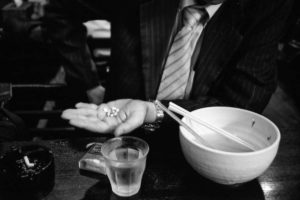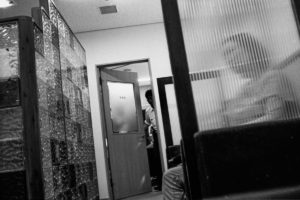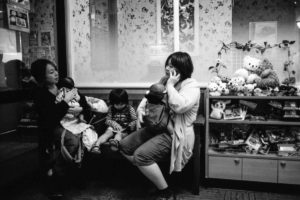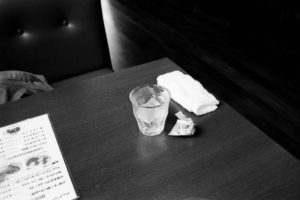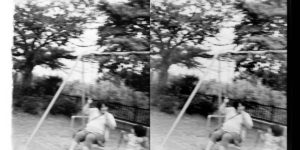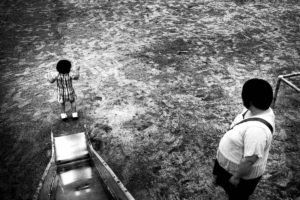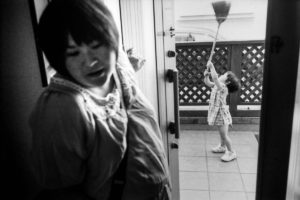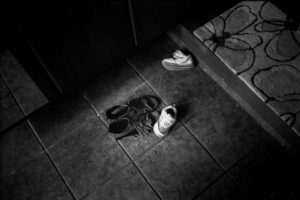Saisei – 再生
The annual number of suicides in Japan is close to 30,000 and it is estimated that the number of people who attempt suicide is at least ten times higher than that of suicides. Therefore, it can be said that more than 300,000 people try to kill themselves each year in Japan. This is very high compared with other countries and it seems to concisely represent the distortions and inequities of Japanese society.
“再生-Saisei-” is a project that focuses on visualizing the lives of those who attempted suicide and coincidentally survived. ‘Saisei’ in Japanese means to come to life again and to recover over time.
Case 1
A.F., a 43-year-old man, decided to commit suicide three years ago. He had just been betrayed by his loved one, and at the same time, the workload imposed by a company exceeded his capacity. He was sick with stress, unable to think about the future and feeling hopeless. He had been plagued by family disagreements and relationship problems, but at that time, several causes unfortunately overlapped in his life. He was mentally driven into a corner. He tried to pretend to be calm, but he said he was not in a healthy state of mind. “I was very tired. I felt lethargic and didn’t care about anything.”
One day at the midnight, A.F. hanged himself on a beam on the second floor of the house using canoe ropes, his hobby.
A.F. lived with his hearing-impaired grandfather. When A.F. hung himself at the midnight, his grandfather happened to notice the noise upstairs. His grandfather later said he somehow had a bad feeling and hurried upstairs. When he entered the room, he found A.F. hanging in the dark. Until the ambulance arrived, his grandfather was struggling to lift his grandson’s leg to ease the strain on his neck. When the ambulance arrived, A.F.’s heart had already stopped.
With the rescue of the paramedics, A.F.’s heart began beating again, but 30 minutes had already passed since it had stopped beating. At the hospital, the doctor told his grandfather that A.F. would be brain dead or would have severe brain sequelae even if he miraculously woke up.
Two weeks later, A.F. woke up in bed. He felt foggy but could speak and move. There was no serious damage to his brain. The doctor called it a miracle.
A.F. returned home after a month in the hospital. And after a year of recuperation at home, luckily, he had a chance to get a new job in programming. In his age and circumstances, he had no other choice.
A.F. decided to make a fresh start on the life he had once given up.
However, it is not easy for a person who has dropped out once to return to society and live again. Because of his age and a slight memory deficit in his brain, he didn’t remember his work well. A.F. is always afraid of being fired. “If the company gets to know about my past suicide attempt, they will think of me as a mentally weak person and won’t let me do my job. I think I’ll be fired soon because I’ve seen many cases like that around me.” Japan is said to be an intolerant society toward those who drop out once, and he realizes the severity of it every day.
A.F. still works for the company. On his way to work, he always stops at a shrine to pray. He says, “I don’t regret trying to die. I’m not glad I survived. It’s hard to live. However, I’m not sure though, I feel that strong will saved my life, so I think I have to live for something else, not just myself.”
Recently, he sometimes goes sea kayaking on holidays. Although he is still struggling with his life, he seems to be trying to regain a positive attitude toward life. “It is very quiet when I am alone in the sea.” he says, “I can forget about things and be free.”
Case 2
M.O. had worked in sales for an IoT company and because of her diligent and amiable character, she always performed at the top of the sales department and was honored several times by the president. When she joined the company, it was the peak of the IoT revolution in Japan, and the company’s growth was remarkable. That’s why the pressure on her and the sales quota was very strict. The company’s slogan “self-growth” was a very convenient way to justify the overwork the company puts on its employees. A few months after she joined the company, she began to suffer from depression caused by job stress.
She had deceived herself into work, but at the age of 30, her mental state finally reached its limit. It suddenly attacked her.
That day, she changed into a dress after putting on makeup because she wanted to be beautiful when she died. She wrote a will and took medicine alone in the room. She said “I don’t remember exactly, but those were over 300 sleeping pills.
Fortunately, her husband found her and called an ambulance. She was unconscious and paramedics immediately lavaged her stomach.
She survived. But when she recovered, she couldn’t find any reason to live. Her mind remained unstable. For her, reintegration into society was not realistic. But one day she got pregnant. The little life gave her hope to live again. She thought life might be simple, she can escape from hardship and live for happiness. Isn’t life just that? “When I was working, I was too busy to look at things calmly. In a very narrow perspective, I think I limited my life.”
At first, her husband blamed her for leaving him and choosing to die, and he did not forgive her, but time has passed and now he understands her and supports her life.
She gave birth to a second child and last year, she began studying to become a psychological counselor. She thought she could make use of her experience in the job. She came to want to do a job that would help others. It was her first step toward social reintegration. She says, “If my life had ended in the day, two lives would not have been born into the world. When I think about it, it is very scary. I’m happy now. Sometimes I wonder if the children were born so that I could live again.”
A.F. and M.O. still take tranquilizers on a daily basis. Sometimes, they say, unexplained despair can strike them. It is not easy for people who want to die to live again in this society. Various obstacles stand in their way. What society can do is not to exclude them, but to watch them with tolerance and help them when necessary.
It may also be for the time when you need their help.
Japan
2011 – ongoing






